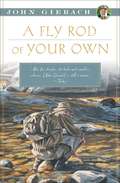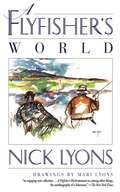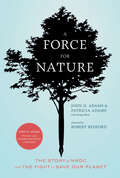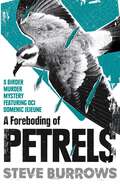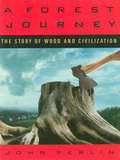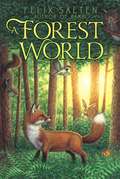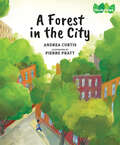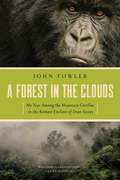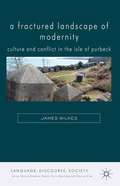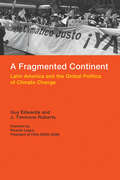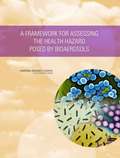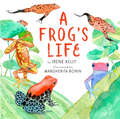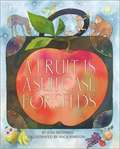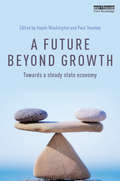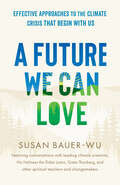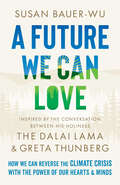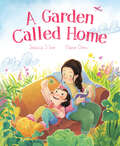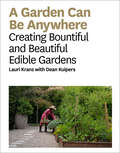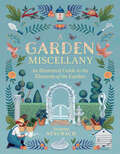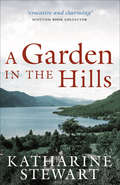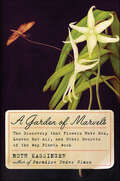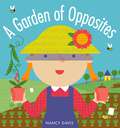- Table View
- List View
A Fly Rod of Your Own (John Gierach's Fly-fishing Library)
by John GierachJohn Gierach, “the voice of the common angler” (The Wall Street Journal) and member of the Fly Fishing Hall of Fame, brings his sharp sense of humor and keen eye for observation to the fishing life and, for that matter, life in general.John Gierach is known for his witty, trenchant observations about fly-fishing. In A Fly Rod of Your Own, Gierach once again takes us into his world and scrutinizes the art of fly-fishing. He travels to remote fishing locations where the airport is not much bigger than a garage and a flight might be held up because a passenger is running late. He sings the praises of the skilled pilots who fly to remote fishing lodges in tricky locations and bad weather. He explains why even the most veteran fisherman seems to muff his cast whenever he’s being filmed or photographed. He describes the all-but-impassable roads that fishermen always seem to encounter at the best fishing spots and why fishermen discuss four-wheel drive vehicles almost as passionately and frequently as they discuss fly rods and flies. And while he’s on that subject, he explains why even the most conscientious fisherman always seems to accumulate more rods and flies than he could ever need. As Gierach says, “fly-fishing is a continuous process that you learn to love for its own sake. Those who fish already get it, and those who don’t couldn’t care less, so don’t waste your breath on someone who doesn’t fish.” From Alaska to the Rockies and across the continent to Maine and the Canadian Maritimes, A Fly Rod of Your Own is an ode to those who fish—and they will get it.
A Flyfisher's World
by Nick Lyons Mari LyonsThis ample selection of articles and essays by one of America's most popular writers about fly-fishing begins with a moment on Michigan's Au Sable River--the exact moment when the author lost his heart to fly-fishing. This collection chronicles a fishing life punctuated by a revealing trip with one of his grown sons and mellow reflections from a hospital bed.This is the broadest of Nick Lyons's books, with sections on tarpon and pike fishing in the Marquesas and in France, bass bugging on a small Connecticut pond, and trout fishing on unnamed creeks and blue-ribbon western rivers, as well as reflections on such aspects of the sport as the flies that are the underpinning of it all, the pursuit of records, the odd characters he's met along the way, and the increasing challenge of crowds who pursue this ever-popular sport.By turns canny, hilarious, inquiring, and philosophic, A Flyfisher's World is an impressive addition to Nick Lyons's important body of writing about fly-fishing.
A Force for Nature: The Story of NRDC and the Fight to Save Our Planet
by John H. Adams Patricia Adams Air Vice Marshal George BlackThe pioneering environmental activist recounts his decades-long fight for our planet through the NDRC—with a foreword by Robert Redford.In 1970, John H. Adams was fed up with the levels of pollution in New York City. How could he raise children in a place where layers of soot covered the windows? Working as a lawyer for the U.S. Attorney’s office, he and fellow lawyers teamed up to form Natural Resources Defense Council, a grassroots environmental advocacy group. Over the years, NDRC has grown into an international powerhouse with 1.2 million members and a staff of scientists and lawyers whose mission is to safeguard the planet. This inspiring memoir tells the story of the NRDC and the environmental movement it sparked.
A Foreboding of Petrels: Birder Murder Mysteries (Birder Murder Mysteries)
by Steve BurrowsOn suspension and unable to work, DCI Domenic Jejeune finds his attention snared by an unexplained death at an Antarctic research base. Meanwhile, DS Danny Maik investigates a string of arson attacks in Norfolk. When a corpse is discovered in a bird hide, Danny&’s investigation escalates. It appears the body links the two enquiries, but the men are unable to share information. As they attempt to unravel a twisted web of leads involving Antarctic researchers, uncompromising climate scientists and billionaire philanthropists, Jejeune is forced to decide how much he is willing to sacrifice in the pursuit of truth. Praise for the series &‘One of the most delightful mysteries of recent years.&’ Daily Mail &‘A most entertaining read.&’ The Times
A Forest Journey: The Story of Wood and Civilization
by John PerlinA contemporary view of the effects of wood, as used for building and fuel, and of deforestation on the development of civilization. Until the ascendancy of fossil fuels, wood has been the principal fuel and building material from the dawn of civilization. Its abundance or scarcity greatly shaped, as A Forest Journey ably relates, the culture, demographics, economy, internal and external politics, and technology of successive societies over the millennia. The book's comprehensive coverage of the major role forests have played in human life--told with grace, fluency, imagination, and humor—gained it recognition as a Harvard Classic in Science and World History and as one of Harvard's "One-Hundred Great Books." Others receiving the honor include such luminaries as Stephen Jay Gould and E. O. Wilson. This new paperback edition will add a prologue and an epilogue to reflect the current situation in which forests have become imperative for humanity's survival.
A Forest World
by Felix SaltenThe forest is a whole different world. . . Felix Salten's classic story of wild and tame animals coming together is brought vividly to life in this refreshed edition. To the animals of Lodge Farm, the woods are a forbidden place filled with danger and uncertainty. For the wild animals in the forest, the farm is just as frightening, because Man lives there. The two worlds are next to one another, but couldn't be further apart. When the groups, tame and wild, begin to interact, each begins to question how life would be different on the other side. Manni the donkey ventures into the forest for an adventure, while a doe and her two fawns seek the safety of the barn when poachers threaten them in the woods. Will the animals choose to stay in their new lives? Or will the call of home be too great?
A Forest in the City (ThinkCities #1)
by Andrea CurtisThis beautiful book of narrative non-fiction looks at the urban forest and dives into the question of how we can live in harmony with city trees. “Imagine a city draped in a blanket of green … Is this the city you know?” A Forest in the City looks at the urban forest, starting with a bird’s-eye view of the tree canopy, then swooping down to street level, digging deep into the ground, then moving up through a tree’s trunk, back into the leaves and branches. Trees make our cities more beautiful and provide shade but they also fight climate change and pollution, benefit our health and connections to one another, provide food and shelter for wildlife, and much more. Yet city trees face an abundance of problems, such as the abundance of concrete, poor soil and challenging light conditions. So how can we create a healthy environment for city trees? Urban foresters are trying to create better growing conditions, plant diverse species, and maintain trees as they age. These strategies, and more, reveal that the urban forest is a complex system—A Forest in the City shows readers we are a part of it. Includes a list of activities to help the urban forest and a glossary. The ThinkCities series is inspired by the urgency for new approaches to city life as a result of climate change, population growth and increased density. It highlights the challenges and risks cities face, but also offers hope for building resilience, sustainability and quality of life as young people act as advocates for themselves and their communities. Key Text Features diagrams author's note glossary sources definitions Correlates to the Common Core State Standards in English Language Arts: CCSS.ELA-LITERACY.RI.4.7 Interpret information presented visually, orally, or quantitatively (e.g., in charts, graphs, diagrams, time lines, animations, or interactive elements on Web pages) and explain how the information contributes to an understanding of the text in which it appears.
A Forest in the Clouds: My Year Among The Mountain Gorillas In The Remote Enclave Of Dr. Dian Fossey
by John FowlerFor the first time, a riveting insider's account of the fascinating world of Dr. Dian Fossey’s mountain gorilla camp, telling the often-shocking story of the unraveling of Fossey’s Rwandan facility alongside adventures tracking mountain gorillas over hostile terrain, confronting aggressive silverbacks, and rehabilitating orphaned baby gorillas. In A Forest in the Clouds, John Fowler takes us into the world of Karisoke Research Center, the remote mountain gorilla camp of Dr. Dian Fossey, a few years prior to her gruesome murder. Drawn to the adventure and promise of learning the science of studying mountain gorillas amid the beauty of Central Africa’s cloud forest, Fowler soon learns the cold harsh realities of life inside Fossey’s enclave ten thousand feet up in the Virunga Volcanoes. Instead of the intrepid scientist he had admired in the pages of National Geographic, Fowler finds a chain-smoking, hard-drinking woman bullying her staff into submission. While pressures mount from powers beyond Karisoke in an effort to extricate Fossey from her domain of thirteen years, she brings new students in to serve her most pressing need—to hang on to the remote research camp that has become her mountain home. Increasingly bizarre behavior has targeted Fossey for extrication by an ever-growing group of detractors—from conservation and research organizations to the Rwandan government. Amid the turmoil, Fowler must abandon his own research assignments to assuage the troubled Fossey as she orders him on illegal treks across the border into Zaire, over volcanoes, in search of missing gorillas, and to serve as surrogate parent to an orphaned baby ape in preparation for its traumatic re-introduction into a wild gorilla group. This riveting story is the only first-person account from inside Dian Fossey’s beleaguered camp. Fowler must come to grips with his own aspirations, career objectives, and disappointments as he develops the physical endurance to keep up with mountain gorillas over volcanic terrain in icy downpours above ten thousand feet, only to be affronted by the frightening charges of indignant giant silverbacks or to be treed by aggressive forest buffalos. Back in camp, he must nurture the sensitivity and patience needed for the demands of rehabilitating an orphaned baby gorilla. A Forest in the Clouds takes the armchair adventurer on a journey into an extraordinary world that now only exists in the memories of the very few who knew it.
A Fractured Landscape of Modernity
by James WilkesThis book uses the contradictions, fractures and coincidences of a twentieth-century rural landscape to explore new methods of writing place beyond 'new nature writing'. In doing so it opens up new ways of reading modernist artists and writers such as Vanessa Bell, Mary Butts and Paul Nash.
A Fragmented Continent: Latin America and the Global Politics of Climate Change (Politics, Science, and the Environment)
by J. Timmons Roberts Guy EdwardsHow Latin American countries became leading voices and innovators on addressing climate change—and what threatens their leadership.Latin American countries have increased their influence at the United Nations climate change negotiations and offered potential solutions on coping with global warming. But in the face of competing priorities, sometimes these climate policies are jettisoned, undermined, or simply ignored. A Fragmented Continent focuses on Latin America's three major blocs at the U.N. climate negotiations and how they attempt to balance climate action with building prosperity. Brazil has reduced its deforestation but continues its drive for economic growth and global recognition. A leftist group led by Venezuela, Bolivia, and Ecuador decries the injustice of climate change but is highly dependent on the export of fossil fuels. A new group, including Chile, Costa Rica, and Peru and supported by Mexico, offers sharp reductions in their carbon emissions in return for greater action by others; these countries now have to deliver on their promises. Weaving together issues of politics and economy, trade, foreign policy, civil society, and environmental protection, A Fragmented Continent offers a long-missing perspective on one of this century's greatest challenges and neglected regions.
A Framework for Assessing the Health Hazard Posed by Bioaerosols
by National Research Council of the National AcademiesBiological warfare agent (BWA) detectors are designed to provide alerts to military personnel of the presence of dangerous biological agents. Detecting such agents promptly makes it possible to minimize contamination and personnel exposure and initiate early treatment. It is also important, though, that detectors not raise an alarm when the situation does not warrant it. The question considered in this book is whether Agent-Containing Particles per Liter of Air (ACPLA) is an appropriate unit of measure for use in the evaluation of aerosol detectors and whether a better, alternative measure can be developed. The book finds that ACPLA alone cannot determine whether a health threat exists. In order to be useful and comparable across all biological agents and detection systems, measurements must ultimately be related to health hazard. A Framework for Assessing the Health Hazard Posed by Bioaerosols outlines the possibility of a more complex, but more useful measurement framework that makes it possible to evaluate relative hazard by including agent identity and activity, particle size, and infectious dose.
A Frog's Life
by Irene KellyA stunningly illustrated introduction to our planet's many frog species!Frogs, frogs, and more frogs! This exciting survey of the world's frog species will introduce children to varieties as diverse as the golden poison frog (the planet's most toxic animal), the Amau frog (so tiny it's no bigger than a housefly), and the Chinese gliding frog (which can "fly" up to 17 feet)! Their different hunting techniques, preferred foods, body types, and methods of defense are covered, as are the universal basics of the frog life cycle. Colorful, scientifically accurate illustration is paired with a distinguished nonfiction writer's plain, energetic text in this excellent introduction to the diversity and fundamentals of frogs. Back matter includes information on frog disappearances and conservation efforts.A Cybils Awards Finalist in the Elementary Nonfiction category!
A Fruit Is a Suitcase for Seeds
by Jean RichardsA description of seed dispersal by which plants, most specifically fruits, travel from one place to another.
A Future Beyond Growth: Towards a steady state economy
by Haydn Washington Paul TwomeyThere is a fundamental denial at the centre of why we have an environmental crisis – a denial that ignores that endless physical growth on a finite planet is impossible. Nature provides the ecosystem services that support our civilisation, thus making humanity unavoidably dependent upon it. However, society continues to ignore and deny this dependence. A Future Beyond Growth explores the reason why the endless growth economy is fundamentally unsustainable and considers ways in which society can move beyond this to a steady state economy. The book brings together some of the deepest thinkers from around the world to consider how to advance beyond growth. The main themes consider the deep problems of the current system and key aspects of a steady state economy, such as population; throughput and consumerism; ethics and equity; and policy for change. The policy section and conclusion bring together these various themes and indicates how we can move past the growth economy to a truly sustainable future. This volume will be of great interest to students and scholars of economics, sustainability and environmental studies in general.
A Future We Can Love: Effective Approaches to the Climate Crisis That Begin with Us
by Susan Bauer-WuDiscover wisdom and guidance to face the climate emergency from the most influential spiritual and environmental leaders of our time, including the Dalai Lama, Greta Thunberg, Joanna Macy, Vandana Shiva, Paul Hawken, Katharine Hayhoe, and Matthieu Ricard. When the Dalai Lama and Greta Thunberg spoke for the first time in January 2021, millions of people around the world took notice. &“It is encouraging to see how you have opened the eyes of the world to the urgency to protect our planet, our only home,&” the Dalai Lama wrote to Greta before their meeting. A Future We Can Love shares the words of these two great figures, generations apart, bringing them into dialogue with dozens of visionary scientists, activists, and spiritual luminaries. These include indigenous scholar and artist Lyla June, medical biochemist and author Diana Beresford-Kroeger, climate scientist and Zen teacher Kritee Kanko, interfaith environmental leader Dekila Chungyalpa, Buddhist teacher Willa Blythe Baker, Rabbi Steve Leder, and many more. Through this world-changing conversation, readers embark on a four-part journey toward active hope in the face of the climate crisis: from knowledge of climate science, through the capacity for change, and to the will that is needed and the actions we can take. The book will help you: comfort your climate anxiety and metabolize grief or burnout into wonderment and useful energyrecognize interdependence as key to our well-being and as a lens for understanding both the climate crisis and its solutionsclarify why feedback loops leave us no time to wait on climate actiondevelop your own rituals and practices for connecting to Earth and renewing hopeovercome common obstacles to speaking and acting clearly on behalf of the human and wild communities most affected by the climate crisisA Future We Can Love inspires each of us to rise to the occasion to ensure a brighter future for generations to come.
A Future We Can Love: How We Can Reverse the Climate Crisis with the Power of Our Hearts and Minds
by Stephanie Higgs Susan Bauer-WuDiscover wisdom and guidance to face the climate emergency from the most influential spiritual and environmental leaders of our time, including the Dalai Lama, Greta Thunberg, Joanna Macy, Vandana Shiva, Paul Hawken, Katharine Hayhoe, and Matthieu Ricard. When the Dalai Lama and Greta Thunberg spoke for the first time in January 2021, millions of people around the world took notice. &“It is encouraging to see how you have opened the eyes of the world to the urgency to protect our planet, our only home,&” the Dalai Lama wrote to Greta before their meeting. A Future We Can Love shares the words of these two great figures, generations apart, bringing them into dialogue with dozens of visionary scientists, activists, and spiritual luminaries. These include indigenous scholar and artist Lyla June, medical biochemist and author Diana Beresford-Kroeger, climate scientist and Zen teacher Kritee Kanko, interfaith environmental leader Dekila Chungyalpa, Buddhist teacher Willa Blythe Baker, Rabbi Steve Leder, and many more. Through this world-changing conversation, readers embark on a four-part journey toward active hope in the face of the climate crisis: from knowledge of climate science, through the capacity for change, and to the will that is needed and the actions we can take. The book will help you: comfort your climate anxiety and metabolize grief or burnout into wonderment and useful energyrecognize interdependence as key to our well-being and as a lens for understanding both the climate crisis and its solutionsclarify why feedback loops leave us no time to wait on climate actiondevelop your own rituals and practices for connecting to Earth and renewing hopeovercome common obstacles to speaking and acting clearly on behalf of the human and wild communities most affected by the climate crisisA Future We Can Love inspires each of us to rise to the occasion to ensure a brighter future for generations to come.
A Game of Golf: A Book of Reminiscence (The\sportstown Ser.)
by Francis OuimetFrancis Ouimet (1893-1967) was an unknown twenty-year-old amateur when he upset famed British golfers Harry Vardon and Ted Ray to win the 1913 U.S. Open. That spectacular victory at The Country Club (TCC) made him America’s first golf hero, drew new fans to the sport, and forever altered the image of golf as a stuffy, rich man’s game dominated by British and Scottish players.In this engaging memoir, first published in 1932, Ouimet reminisces about his life in golf and gives sage advice on playing the game. He vividly chronicles the boyhood he spent at his modest home across the street from The Country Club in Brookline, Massachusetts. With charm and wit he recalls how he scavenged for golf balls and clubs, learned to play on a homemade, three-hole course in his backyard, and sneaked onto The Country Club’s fairways to practice in the early morning hours. He recounts his caddying years, starting at age nine, the early amateur competitions, and the momentous 1913 U.S. Open tournament on his neighborhood course.Legendary is the story of Ouimet and his caddy, Eddie Lowery. Ouimet refused an experienced TCC member’s offer to carry his clubs during the 1913 playoff in favor of the ten-year-old boy.Ouimet’s illustrious amateur career journeys across the fairways of Hoylake, St. Andrews, Garden City, and Pebble Beach, and concludes with his victory in the 1931 U.S. National Amateur at Beverly Hills in Chicago.Brimming with exciting matches and great players such as Bobby Jones and Walter Hagen, these humble reminiscences of the working-class kid who changed the game of golf will inspire golf enthusiasts and general readers alike.
A Garden Called Home
by Jessica J. LeeWhat makes the place we live feel like home? This is a warm-hearted and lush picture book about family, the immigrant experience and how a simple garden can foster a connection to the larger natural world.Mama was born in a country far away from here. I love her stories about warm rain in winter and green mountains. And now Mama's taking me there! When a young girl and her mother go to visit her family, the girl notices a change. At home, her mother mostly stays inside. Here, her mother likes to explore and go hiking. The girl has never seen her so happy! Her mother tells her about the trees, bushes, flowers and birds. Did you know that tree roots make mountains strong? And that ài hāo (mugwort) is used to make delicious, sweet dumplings?But her mother's smile goes away when they return home. It's cold and she doesn't want to go outside. She goes back to wearing her big quilted jackets and watering her houseplants.How can the girl show her mother that nature here can be wondrous too?Includes a glossary of plants with Mandarin/English words.
A Garden Can Be: Creating Bountiful and Beautiful Edible Gardens
by Dean Kuipers Lauri Kranz“Kranz’s facility at simplifying the process of raising fava beans or beets or lemon verbena—yes, anywhere—will have you scouring seed catalogs.” —NewsweekEdible Gardens LA founder Lauri Kranz shares her secrets for planning, planting, growing, and maintaining luscious edible gardens, no matter the setting or size of the plot. Through gorgeous gardens created for her well-known clientele, including James Beard Award–winning chefs, celebrities, rock stars, and more, Lauri shares her essential methods for growing abundant organic food. This practical guide is built around Lauri’s philosophy that nourishment and beauty are not separate goals. It’s also at the forefront of a gardening revolution, where more and more people are craving a patch of land for growing and the trend is toward edible gardens over ornamental gardens. A Garden Can Be Anywhere reveals Lauri’s knack for providing both beauty and bounty in her clients’ outdoor spaces.“Every time I see Lauri, I come away feeling nourished. Her superpower is her warmth, and her ease that makes any conversation about your garden feel empowering. She is a grounding force that strips away any gardening intimidation and makes you feel strong, capable, joyful. There’s no ego in her approach; she’s really rooting for you. Being around Lauri is such a gift.” —Maya Rudolph, actor, comedian, singer“The book takes readers through the process—step-by-step—of designing and growing a beautiful home garden.” —Gardenista“Lauri Kranz not only set up my edible garden, but also created and established a relationship between me and my backyard. She is the Tinder for me and my vegetables.” —Nicole Richie, fashion designer, author, actor
A Garden Miscellany: An Illustrated Guide to the Elements of the Garden
by Suzanne Staubach“A pleasure to read and a valuable resource to fall back on for the enthusiastic gardener.” —Publishers Weekly Do you know a folly from a ha-ha? Can an allée be pleached? Does a skep belong on a plinth? Answers to these questions—plus a gazebo-ful of information, stories, and visual delights—await in this charming exploration of the stuff gardens are made of. Garden historian Suzanne Staubach covers everything from arbors to water features, reveling in the anecdotes that accompany each element. Filled with revelations and fanciful illustrations by Julia Yellow, A Garden Miscellany promises new discoveries with each reading—a book to be returned to again and again.
A Garden in the Hills
by Katharine StewartThe author of the classic A Croft in the Hills takes us through a year in her Scottish Highlands garden and its many delights. This illustrated book celebrates one of humankind&’s oldest pleasures. Month by month, we are taken through a year in the life of Katharine Stewart&’s garden outside the old schoolhouse in Abriachan, Scotland, where she lives with her husband and daughter. The circle of the seasons is luminously evoked as we are told of the practicalities of gardening, cooking, beekeeping, and winemaking. From a winner of a Saltire Society Award for her contribution to the understanding of Scottish Highland culture, and peppered with warm personal insights, good humor, and a love of living things, this account of the joy of nature reminds us how rewarding it is to be outdoors. &“Evocative and charming.&” —Scottish Book Collector
A Garden of Flowers: All 104 Engravings from the Hortus Floridus of 1614 (Dover Pictorial Archive Ser.)
by Crispin van de PassExcellent reproduction teems with accurate, full-page images of garden flowers. Information on each plant describes leaves, flowers, seed pods, roots, and size and color of each blossom. 104 black-and-white illustrations.
A Garden of Marvels: How We Discovered that Flowers Have Sex, Leaves Eat Air, and Other Secrets of Plants
by Ruth KassingerIn the tradition of The Botany of Desire and Wicked Plants, a witty and engaging history of the first botanists interwoven with stories of today’s extraordinary plants found in the garden and the lab.In Paradise Under Glass, Ruth Kassinger recounted with grace and humor her journey from brown thumb to green, sharing lessons she learned from building a home conservatory in the wake of a devastating personal crisis.In A Garden of Marvels, she extends the story. Frustrated by plants that fail to thrive, she sets out to understand the basics of botany in order to become a better gardener. She retraces the progress of the first botanists who banished myths and misunderstandings and discovered that flowers have sex, leaves eat air, roots choose their food, and hormones make morning glories climb fence posts. She also visits modern gardens, farms, and labs to discover the science behind extraordinary plants like one-ton pumpkins, a truly black petunia, a biofuel grass that grows twelve feet tall, and the world's only photosynthesizing animal. Transferring her insights to her own garden, she nurtures a "cocktail" tree that bears five kinds of fruit, cures a Buddha's Hand plant with beneficial fungi, and gets a tree to text her when it's thirsty.Intertwining personal anecdote, accessible science, and untold history, the ever-engaging author takes us on an eye-opening journey into her garden—and yours.
A Garden of Opposites
by Nancy DavisEnter this beautiful garden and see what opposites you’ll find! A short caterpillar and a long garden snake, a closed bud and an open blossom. These delightful images will teach youngsters about basic opposite concepts, and about the charms and wonders of the outdoors!This simple book has a surprise treat at the end—a gatefold displaying the whole garden, with opposites galore for little ones to search for. Plus, sturdy cardstock pages make this book perfect for reading indoors . . . or for taking to the park!
A Gardener's Alphabet
by Mary Azarian"Arbor, bulb, compost..." An alphabet book for beginning readers.
